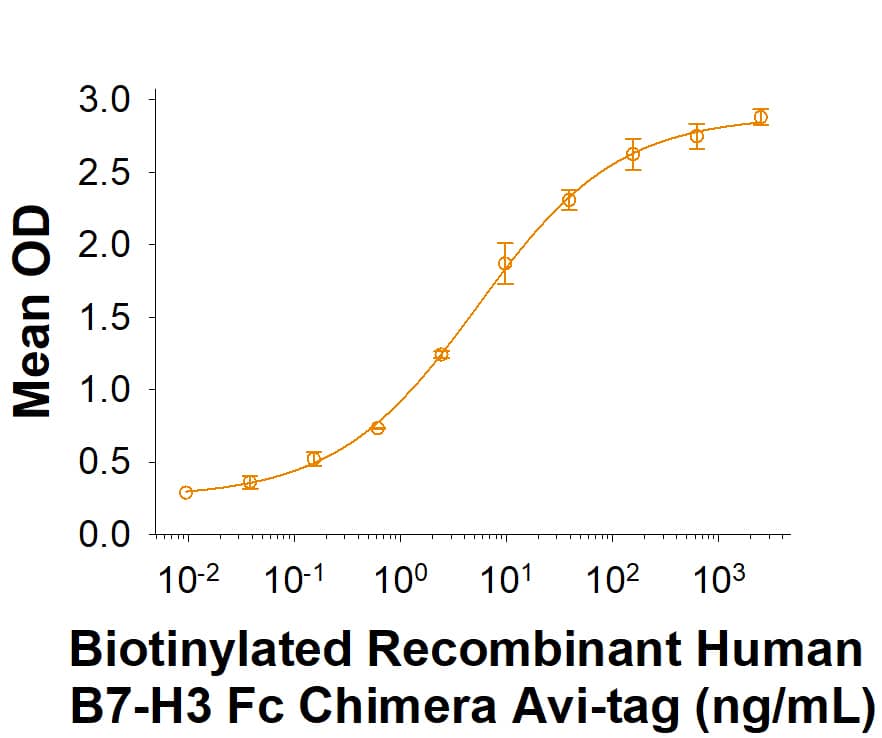Recombinant Human B7-H3 Fc Chimera Avi-tag Protein, CF
R&D Systems, part of Bio-Techne | Catalog # AVI1027
Biotinylated

Key Product Details
Learn more about Avi-tag Biotinylated Proteins
Source
CHO
Accession #
Structure / Form
Disulfide-linked homodimer, biotinylated via Avi-tag
Conjugate
Biotin
Applications
Bioactivity
Product Specifications
Source
Chinese Hamster Ovary cell line, CHO-derived human B7-H3 protein
| Human B7-H3 (Leu29-Pro245) Accession # NP_079516.1 |
DIEGRMD | Human IgG1 (Pro100-Lys330) |
Avi-tag |
| N-terminus | C-terminus | ||
Purity
>95%, by SDS-PAGE visualized with Silver Staining and quantitative densitometry by Coomassie® Blue Staining.
Endotoxin Level
<0.10 EU per 1 μg of the protein by the LAL method.
N-terminal Sequence Analysis
Leu29
Predicted Molecular Mass
52 kDa
SDS-PAGE
62-74 kDa, under reducing conditions
Activity
Measured by its ability to inhibit anti-CD3 antibody induced IL-2 or IFN-gamma secretion by human T cells.
The ED50 for this effect is 1-10 µg/mL.
Measured by its binding ability in a functional ELISA.
When Human B7-H3 Antibody (Catalog # AF1027) is immobilized at 1 μg/mL, 100 μL/well, the concentration of Biotinylated Recombinant Human B7-H3 Fc Chimera Avi-tag (Catalog # AVI1027) that produces 50% of the optimal binding response is approximately 3-18 ng/mL.
The ED50 for this effect is 1-10 µg/mL.
Measured by its binding ability in a functional ELISA.
When Human B7-H3 Antibody (Catalog # AF1027) is immobilized at 1 μg/mL, 100 μL/well, the concentration of Biotinylated Recombinant Human B7-H3 Fc Chimera Avi-tag (Catalog # AVI1027) that produces 50% of the optimal binding response is approximately 3-18 ng/mL.
Scientific Data Images for Recombinant Human B7-H3 Fc Chimera Avi-tag Protein, CF
Recombinant Human B7-H3 Fc Chimera Avi-tag Protein Binding Activity.
When Human B7-H3 Antibody (AF1027) is immobilized at 1 μg/mL, 100 μL/well, the concentration of Biotinylated Recombinant Human B7-H3 Fc Chimera Avi-tag (Catalog # AVI1027) that produces 50% of the optimal binding response is approximately 3-18 ng/mL.Biotinylated Recombinant Human B7-H3 Fc Chimera Avi-tag SDS-PAGE.
2 μg/lane of Biotinylated Recombinant Human B7-H3 Fc Chimera Avi-tag Protein (Catalog # AVI1027) was resolved with SDS-PAGE under reducing (R) and non-reducing (NR) conditions and visualized by Coomassie® Blue staining, showing bands at 62-74 kDa and 120-150 kDa, respectively.Formulation, Preparation and Storage
AVI1027
| Formulation | Lyophilized from a 0.2 μm filtered solution in PBS with Trehalose. |
| Reconstitution | Reconstitute at 500 μg/mL in PBS. |
| Shipping | The product is shipped at ambient temperature. Upon receipt, store it immediately at the temperature recommended below. |
| Stability & Storage | Use a manual defrost freezer and avoid repeated freeze-thaw cycles.
|
Background: B7-H3
References
- Coyle, A.J. and J.-C. Gutierrez-Ramos (2001) Nature Immunol. 2:203.
- Chapoval, A.I. et al. (2001) Nature Immunol. 2:269.
- Sun, M. et al. (2002) J. Immunol. 168:6294.
- Steinberger, et al. (2004) J. Immunol. 172:2352.
- Ling, V. et al. (2003) Genomic 82:365.
Long Name
B7 Homolog 3
Alternate Names
B7H3, CD276
Gene Symbol
CD276
UniProt
Additional B7-H3 Products
Product Documents for Recombinant Human B7-H3 Fc Chimera Avi-tag Protein, CF
Product Specific Notices for Recombinant Human B7-H3 Fc Chimera Avi-tag Protein, CF
For research use only
